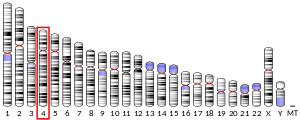GPM6A
Neuronal membrane glycoprotein M6-a is a protein that in humans is encoded by the GPM6A gene.[5][6][7]
References
- GRCh38: Ensembl release 89: ENSG00000150625 - Ensembl, May 2017
- GRCm38: Ensembl release 89: ENSMUSG00000031517 - Ensembl, May 2017
- "Human PubMed Reference:". National Center for Biotechnology Information, U.S. National Library of Medicine.
- "Mouse PubMed Reference:". National Center for Biotechnology Information, U.S. National Library of Medicine.
- Olinsky S, Loop BT, DeKosky A, Ripepi B, Weng W, Cummins J, et al. (May 1996). "Chromosomal mapping of the human M6 genes". Genomics. 33 (3): 532–6. doi:10.1006/geno.1996.0231. PMID 8661015.
- Liang YJ, Wu DF, Stumm R, Höllt V, Koch T (July 2008). "Membrane glycoprotein M6A promotes mu-opioid receptor endocytosis and facilitates receptor sorting into the recycling pathway". Cell Research. 18 (7): 768–79. doi:10.1038/cr.2008.71. PMID 18574501.
- "Entrez Gene: GPM6A glycoprotein M6A".
Further reading
- Boks MP, Hoogendoorn M, Jungerius BJ, Bakker SC, Sommer IE, Sinke RJ, et al. (September 2008). "Do mood symptoms subdivide the schizophrenia phenotype? Association of the GMP6A gene with a depression subgroup". American Journal of Medical Genetics. Part B, Neuropsychiatric Genetics. 147B (6): 707–11. doi:10.1002/ajmg.b.30667. PMID 18163405.
- DeGiorgis JA, Jaffe H, Moreira JE, Carlotti CG, Leite JP, Pant HC, Dosemeci A (2005). "Phosphoproteomic analysis of synaptosomes from human cerebral cortex". Journal of Proteome Research. 4 (2): 306–15. doi:10.1021/pr0498436. PMID 15822905.
- Shin BK, Wang H, Yim AM, Le Naour F, Brichory F, Jang JH, et al. (February 2003). "Global profiling of the cell surface proteome of cancer cells uncovers an abundance of proteins with chaperone function". The Journal of Biological Chemistry. 278 (9): 7607–16. doi:10.1074/jbc.M210455200. PMID 12493773.
- Mukobata S, Hibino T, Sugiyama A, Urano Y, Inatomi A, Kanai Y, et al. (October 2002). "M6a acts as a nerve growth factor-gated Ca(2+) channel in neuronal differentiation". Biochemical and Biophysical Research Communications. 297 (4): 722–8. doi:10.1016/S0006-291X(02)02284-2. PMID 12359212.
- Shimizu F, Watanabe TK, Fujiwara T, Takahashi E, Nakamura Y, Maekawa H (1996). "Isolation and mapping of the human glycoprotein M6 gene (GPM6A) to 4q33-->q34". Cytogenetics and Cell Genetics. 74 (1–2): 138–9. doi:10.1159/000134401. PMID 8893821.
- Yan Y, Narayanan V, Lagenaur C (July 1996). "Expression of members of the proteolipid protein gene family in the developing murine central nervous system". The Journal of Comparative Neurology. 370 (4): 465–78. doi:10.1002/(SICI)1096-9861(19960708)370:4<465::AID-CNE4>3.0.CO;2-2. PMID 8807448.
This article is issued from Wikipedia. The text is licensed under Creative Commons - Attribution - Sharealike. Additional terms may apply for the media files.





